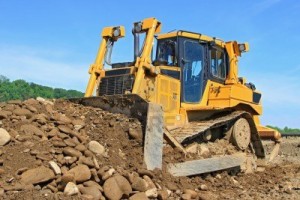How do Bulldozers Work
Designed to move or demolish all in their path, these powerful vehicles are used by builders, farmers and even soldiers.
Key to how a bulldozer operates is its large powerful engine and tracks, which combined allow the machine to push, pull and carry many-ton loads day in, day out. This is because the tracks generate excellent ground hold and weight distribution, preventing the bulldozer from becoming stuck or slipping on difficult terrain. This ability, in partnership with the vast amount of torque generated by the vehicle’s diesel engine and torque divider, allows substantial loads to be manipulated with ease – indeed, modern bulldozers can pull tanks that weigh over 70 tons!
A bulldozer consists of many parts, but the three most noteworthy are its blade, tracks and ripper. Affixed to the front of the vehicle by a push frame, the blade is the heavy metal plate that’s used to push objects and scoop up large quantities of material such as sand and earth. This element is usually one of three designs: an S blade, which is short and has no lateral curve and side wings; a U blade, which is tall and very curved with pronounced side wings that can gather more material; or an S-U blade, which is a combination of the other two types.
The tracks of a bulldozer also come in a variety of designs, though oval and triangle arrays are most common. A popular track system today is Caterpillar’s triangular high-drive system, which is designed to generate a higher cab position for the driver – granting them better visibility during operation. This configuration also enhances the vehicle’s balance and traction across all applications. For example, high-drive bulldozers deliver equal amounts of stability and grip no matter whether they are pushing, pulling or carrying their colossal loads.
 The last key part is the bulldozer’s ripper. This is a tool attached to the rear of the vehicle that’s powered by a hydraulic cylinder. The ripper usually resembles a toothed blade – or series of toothed blades – and is used to break up hard ground so it can be scooped up or pushed by the blade. Rippers are designed with replaceable tungsten steel alloy tips to ensure they remain razor sharp. In addition, rippers can be modified to perform other tasks. A case in point are stump-buster rippers, which are sharp, horizontally mounted rear blades used specifically to split and shred tree stumps.
The last key part is the bulldozer’s ripper. This is a tool attached to the rear of the vehicle that’s powered by a hydraulic cylinder. The ripper usually resembles a toothed blade – or series of toothed blades – and is used to break up hard ground so it can be scooped up or pushed by the blade. Rippers are designed with replaceable tungsten steel alloy tips to ensure they remain razor sharp. In addition, rippers can be modified to perform other tasks. A case in point are stump-buster rippers, which are sharp, horizontally mounted rear blades used specifically to split and shred tree stumps.
Due to their extreme power and performance, bulldozers have increasingly been called into military service, if greatly adapted for warzones. Modifications include armour plating, blast shields, bulletproof cab glass, machine guns and enhanced communication systems with GPS. A good example is the Caterpillar D9R (nicknamed Doobi – Hebrew for ‘teddy bear’), which has been used by the Israel Defense Forces (IDF) for several decades.
Facts about bulldozers
 1. Crawler – The term bulldozer was originally an engineering term to describe a horizontal forging press. It was not until the Thirties that the name was linked to the modern-day crawler vehicle.
1. Crawler – The term bulldozer was originally an engineering term to describe a horizontal forging press. It was not until the Thirties that the name was linked to the modern-day crawler vehicle.
2. Tractor roots – The first bulldozers were not purpose built but modified farm tractors. In the Twenties, however, purpose-built machines with tracks started to be manufactured and sold.
3. Caterpillar – The largest manufacturer of bulldozers is US company Caterpillar. Competitors include Komatsu, JCB and John Deere, which all produce vehicles of various sizes and specifications.
4. Calfdozer – While the majority of bulldozers are massive, more compact variants are produced for urban use where space is limited. These miniature versions are often called calfdozers.
5. Battle bulldozer – The most famous example of a military bulldozer is the Israel Defense Forces’ Caterpillar D9R, named Doobi. This machine has been rigged out to demolish structures while under fire.
